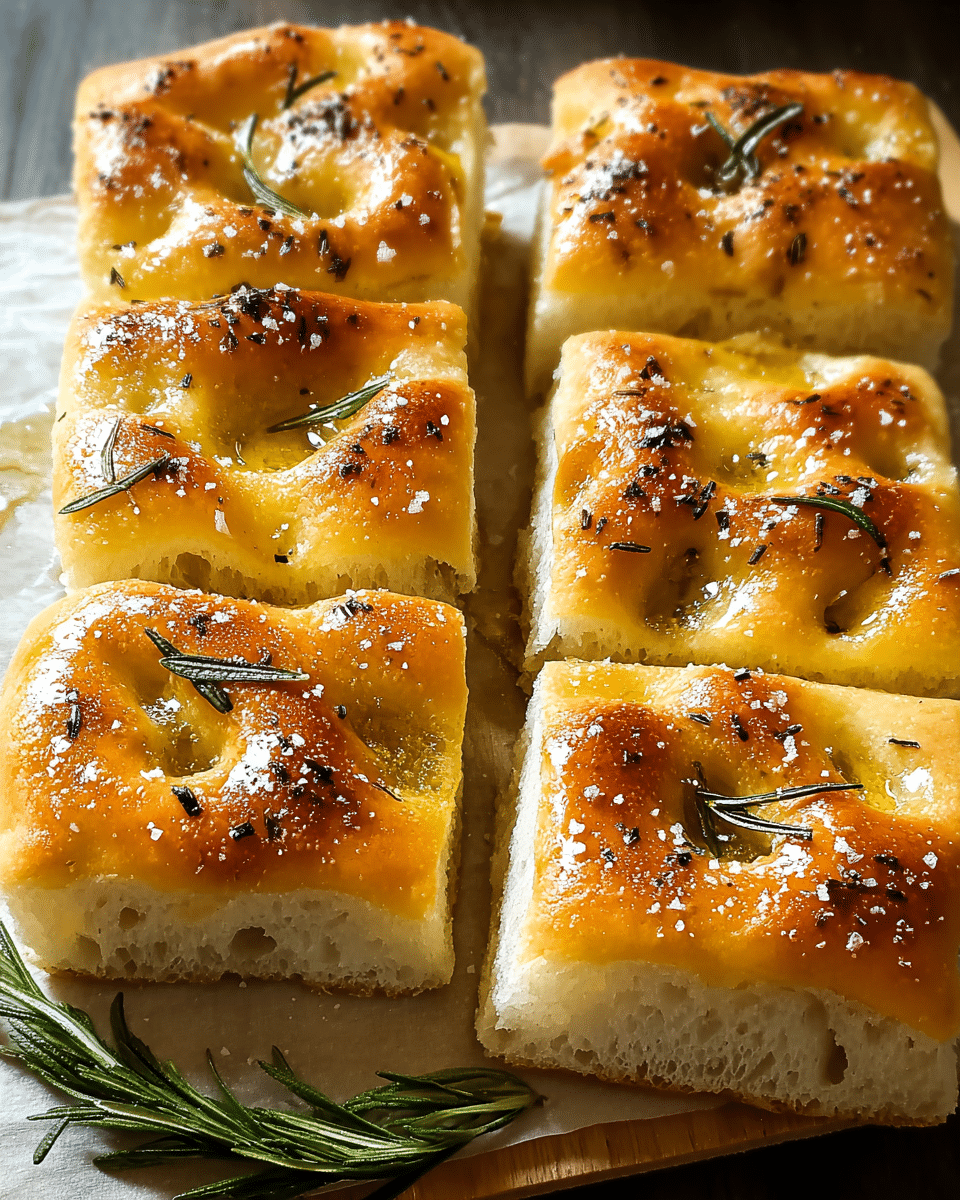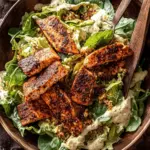The aroma of warm garlic and rosemary wafting from the oven is enough to gather everyone in the kitchen. This Golden Rosemary Garlic Focaccia is a showstopper that pairs beautifully with soups, salads, or served solo with a dip of extra virgin olive oil and balsamic vinegar.
With its crisp edges, soft fluffy crumb, and the signature dimples filled with seasoned olive oil, this focaccia delivers on both texture and flavor. Whether you’re baking it for a family dinner, brunch table, or even slicing it for gourmet sandwiches, this easy focaccia recipe will earn you rave reviews every time
Full Recipe:
Ingredients:
-
2 ¼ teaspoons (1 packet) active dry yeast
-
1 ¾ cups warm water (about 110°F/43°C)
-
1 tablespoon honey or sugar
-
5 cups all-purpose flour
-
1 tablespoon salt
-
½ cup extra virgin olive oil (plus more for drizzling)
-
2–3 sprigs fresh rosemary, chopped
-
4 cloves garlic, thinly sliced
-
Flaky sea salt, to sprinkle
Directions:
-
In a large bowl, mix the warm water, honey, and yeast. Let it sit for 5–10 minutes until foamy.
-
Add the flour and salt to the yeast mixture. Stir until a sticky dough forms.
-
Transfer the dough to a lightly floured surface and knead for 5–6 minutes, or until smooth and elastic.
-
Coat a clean bowl with olive oil, place the dough inside, and cover with a towel or plastic wrap. Let it rise in a warm spot for 1–2 hours or until doubled in size.
-
Generously oil a large baking sheet or 9×13-inch pan. Transfer the risen dough to the pan, stretching it gently to fit.
-
Cover and let it rise again for 30–45 minutes. Meanwhile, preheat the oven to 425°F (220°C).
-
Use your fingers to dimple the dough. Drizzle with olive oil, sprinkle chopped rosemary and sliced garlic evenly, and finish with flaky sea salt.
-
Bake for 20–25 minutes or until golden brown and crisp on top.
-
Let cool slightly before slicing and serving.
Prep Time: 15 minutes | Cooking Time: 25 minutes | Total Time: 2 hours 30 minutes
Kcal: 270 kcal | Servings: 10 slices
Introduction to Focaccia
Focaccia bread is one of the most beloved staples of Italian baking. Known for its golden, crispy crust and light, fluffy interior, focaccia is as versatile as it is delicious. Traditionally baked in sheet pans and generously drizzled with olive oil, this bread has ancient origins that trace back to the Roman Empire, where early flatbreads were cooked on open hearths. Today, focaccia has become a celebrated favorite not just in Italy but across the globe, gracing everything from rustic farmhouse tables to gourmet restaurant menus.
Its charm lies in its simplicity basic ingredients like flour, water, yeast, and olive oil come together to create a loaf that is anything but ordinary. What sets focaccia apart from other breads is its signature dimpled surface, which allows pools of olive oil and herbs to settle into the dough, creating pockets of flavor in every bite. Whether served plain, topped with fresh rosemary and garlic, or adorned with creative toppings like olives, cherry tomatoes, or onions, focaccia is the ultimate canvas for savory expression.
Why Focaccia Is a Must-Have Recipe in Every Kitchen
Homemade focaccia is more than just bread it’s a culinary experience. It’s the smell of yeast and olive oil rising together in the oven. It’s the crackle of a golden crust when it’s sliced. And it’s the joy of pulling apart soft, tender bread with your hands and dipping it into balsamic vinegar or scooping up a saucy entrée.
This recipe in particular is beginner-friendly, requiring no fancy tools, no kneading machines, and no complicated steps. With a little time and patience, even novice bakers can achieve bakery-quality results right at home. The key to great focaccia lies in three things: a well-hydrated dough, a generous amount of olive oil, and ample resting time. Once you’ve mastered the technique, you’ll find yourself coming back to it again and again.
The Magic of Olive Oil and Herbs
One of the hallmarks of a classic focaccia is its luxurious olive oil flavor. Unlike many breads that only use a small amount of fat, focaccia embraces olive oil throughout the entire process from the dough to the baking pan to the final drizzle on top. This not only enhances the flavor but also gives focaccia its signature crispiness and rich color.
Adding herbs like rosemary transforms the flavor profile entirely. Rosemary pairs beautifully with garlic and gives the focaccia an earthy, piney aroma that is unmistakable. You can also experiment with thyme, oregano, or even sage depending on your preferences. Some variations even include roasted garlic, caramelized onions, or a sprinkle of Parmesan cheese for an extra punch of flavor.
Focaccia as a Side, Snack, or Centerpiece
What makes focaccia such a standout in the bread world is how multi-purpose it is. It can be sliced and served as a side with pasta dishes, soups, or stews. It’s an ideal candidate for sandwiches just slice horizontally, fill with meats, cheeses, and veggies, and press. Or serve it as a pre-dinner appetizer with a dip of olive oil and balsamic vinegar.
You can also turn focaccia into a main attraction at parties and gatherings. Dress it up with toppings like cherry tomatoes, olives, caramelized onions, or even roasted peppers for a focaccia that resembles a flatbread pizza. Serve it warm and watch it disappear faster than you can slice it.
For breakfast or brunch, focaccia makes a fantastic savory addition. Pair it with eggs, fresh fruits, and cheeses for a satisfying start to the day. It’s also a favorite among kids when served simply with melted cheese or as mini focaccia bites.
Health Benefits of Homemade Focaccia
While bread is often seen as indulgent, making your own focaccia at home gives you full control over the ingredients, making it a healthier option compared to store-bought versions. You can opt for whole grain flour for added fiber, reduce the salt if you’re watching your sodium intake, and use high-quality extra virgin olive oil which is rich in antioxidants and healthy fats.
Additionally, focaccia is dairy-free and can easily be made vegan. There are no eggs or butter involved in the base recipe, and the flavor is driven by natural ingredients. For those with dietary restrictions, it’s easy to modify the recipe by using gluten-free flour blends or adding toppings to suit a plant-based lifestyle.
The Joy of Baking Bread at Home
There is something incredibly satisfying about baking your own bread. The simple act of combining ingredients and watching them transform into a warm, golden loaf is one of life’s purest pleasures. Focaccia is particularly rewarding because it’s forgiving and adaptable. Even if the dough is a bit sticky or uneven, the result is almost always delicious.
Home-baked focaccia also fills your kitchen with the most comforting aroma a mix of garlic, herbs, and fresh bread that invites everyone to the table. And unlike many breads that require intricate techniques or long fermentation times, focaccia offers almost instant gratification with minimal effort.
It’s a wonderful recipe to make with kids, too. Letting them poke the dough to create those famous dimples, sprinkle the rosemary, and drizzle olive oil makes for an engaging and educational kitchen activity.
Creative Variations to Try
While classic rosemary garlic focaccia is a timeless option, there are so many ways to get creative with your toppings and flavor combinations. Here are just a few ideas:
- Tomato Basil Focaccia: Top with halved cherry tomatoes, fresh basil leaves, and a touch of mozzarella.
- Caramelized Onion Focaccia: Sweet, slow-cooked onions layered over the dough add depth and umami.
- Olive & Sun-Dried Tomato Focaccia: Salty and tangy with a Mediterranean flair.
- Cheesy Focaccia: A generous sprinkling of shredded parmesan or cheddar melted into the top crust.
- Spicy Focaccia: Add chili flakes or sliced jalapeños for a bit of a kick.
The possibilities are endless, and once you’ve made this base recipe, you’ll be inspired to try your own combinations. Think of focaccia as your savory bread canvas.
Storage Tips and Leftover Ideas
Homemade focaccia is best enjoyed fresh, ideally within the first day or two of baking. However, it also stores well when wrapped tightly in plastic wrap or kept in an airtight container. You can warm it in the oven or toaster to bring back that crispy texture.
If you have leftovers, consider:
- Making sandwiches with deli meats, cheese, and arugula
- Turning slices into croutons for soups and salads
- Creating focaccia bread pudding with eggs, cheese, and herbs
- Using it as a pizza base for a quick dinner solution
You can even freeze focaccia in slices for up to a month just thaw and toast before serving.
Conclusion: A Bread Worth Mastering
Whether you’re a seasoned baker or just starting your culinary journey, focaccia is one of the easiest and most rewarding breads you can make at home. With its crisp edges, fluffy interior, and flavorful toppings, it hits the perfect balance between rustic and refined.
It’s not just a recipe it’s an experience. The process of proofing, dimpling, drizzling, and baking connects you with traditions passed down for centuries. And the result is something deeply comforting, totally satisfying, and endlessly customizable.
Make it once, and it will become a staple in your kitchen. Serve it proudly, eat it joyfully, and let your love for bread shine through in every golden bite.






